Hunter boots are renowned for their blend of durability and classic style, often favored for their effectiveness as waterproof rain boots constructed from vulcanized rubber. Their iconic design and resilient material make them a staple in the closets of many, especially in regions with frequent wet weather.
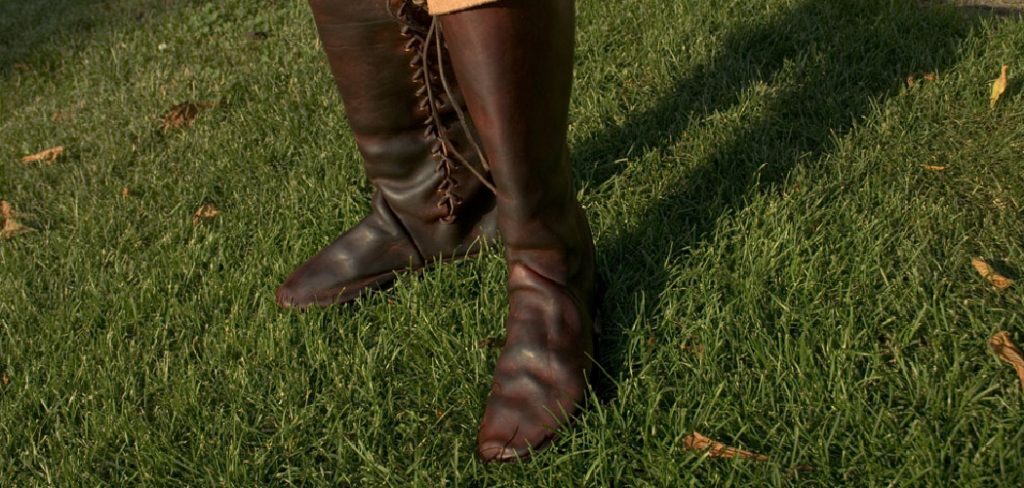
Despite their robust construction, the rubber on Hunter boots can begin to peel. Factors such as exposure to harsh environmental conditions, improper storage methods, or general wear and tear over time can contribute to this issue, affecting the boots’ appearance and functionality.
This guide aims to demystify the causes behind rubber peeling in Hunter boots and provide practical, step-by-step instructions on how to fix peeling Hunter boots efficiently. With careful attention to repair techniques and preventive measures, owners can maintain their boots’ longevity and visual appeal.
Why Hunter Boots Peel
A. Causes of Peeling
While known for their durability, Hunter boots can experience peeling for several reasons. One primary factor is sun and UV exposure. Prolonged exposure to the sun’s rays can cause the rubber to dry out and crack, ultimately leading to peeling. Another common cause is improper storage.
Storing Hunter boots in hot or humid environments can weaken the rubber, making it more prone to this type of damage. Furthermore, normal wear and tear also contribute significantly. Over time, the constant bending, flexing, and exposure to environmental elements can degrade the rubber, leading to surface damage and potential peeling.
A combination of these factors can compromise the integrity of the rubber, even in high-quality boots like Hunters, making regular maintenance and proper care essential to their longevity.
B. Types of Peeling
There are generally two types of peeling that can affect Hunter boots. The first type is surface peeling, which occurs as minor peeling on the outer layer of the boot. This type is often less severe and can usually be fixed with a suitable repair product, ensuring the longevity of the footwear.
In contrast, deep peeling or cracking is more concerning as it indicates a more severe rubber degradation, often requiring extra attention, such as filling or patching. Addressing these issues promptly is crucial to maintaining the boots’ waterproof qualities and overall appearance.
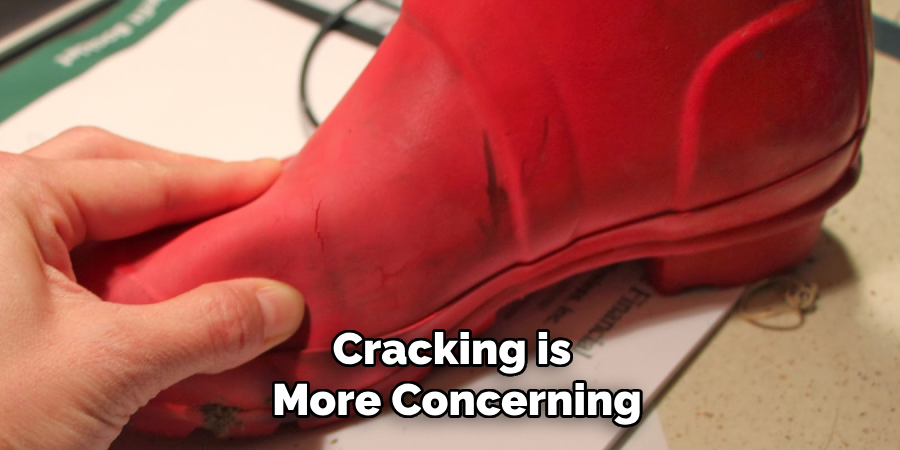
Tools and Materials Needed
A. Tools for the Job
Having the right tools on hand is crucial to effectively fix peeling Hunter boots. Start with clean cloths and a soft brush; these are essential for thoroughly cleaning the boots and removing any dirt or debris before applying repair products.
This step ensures that all surfaces are prepared for bonding and treatment. If desired, you may also use fine sandpaper. This optional tool helps smooth out any rough or peeling areas on the rubber’s surface, creating a clean base that enhances the effectiveness of rubber conditioners or adhesives applied afterward.
B. Materials for Repair
Having the proper materials is equally critical. Begin with a rubber conditioner or UV Tech, which are specialized products aimed at restoring flexibility to rubber while offering protection against future sun damage. They prevent further degradation and maintain the rubber’s integrity.
Next, use rubber cement or adhesive, a strong bonding agent specifically designed to seal any cracks or effectively bond sections of peeling rubber back into place. Finally, employ a boot buffing compound to finish the process. This compound is excellent for restoring the boot’s original shine, ensuring it looks as good as new after the repair.
How to Fix Peeling Hunter Boots: Step-by-Step Guide
Step 1: Clean the Boots
To begin the repair process, it is vital to clean the boots thoroughly. Start by using a damp cloth or a soft brush to wipe down the shoes, effectively removing any dirt, mud, or debris that could interfere with the repair.
Mix a small amount of mild soap with water, then gently wipe the boots to ensure they are cleaned without causing additional damage to the rubber. It is important to avoid harsh chemicals that might lead to further deterioration. After cleaning, let the boots dry completely before moving on to the next repair steps.
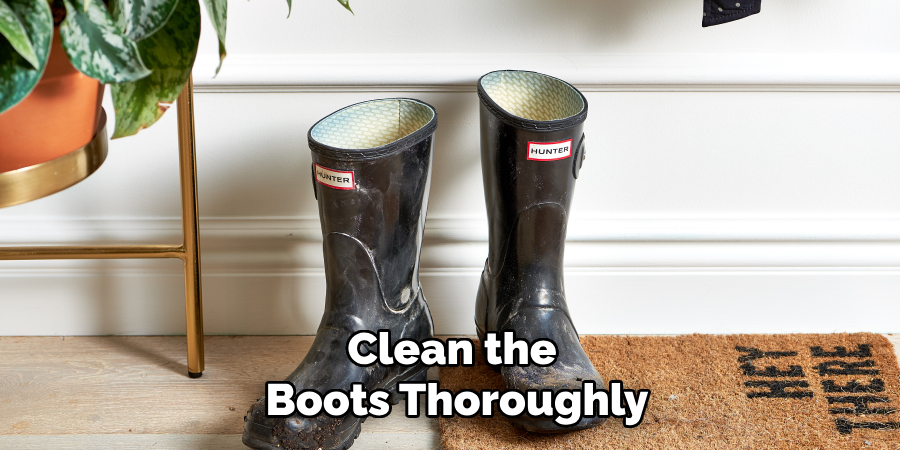
Step 2: Sand Down the Peeling Area (Optional)
If you notice that the rubber is peeling or flaking, you can choose to sand the affected area. Lightly sand the peeling edges with fine sandpaper, smoothing them out without damaging the boot’s surface. Exercise caution during this step to avoid over-sanding, which could weaken the rubber. Once sanding is complete, use a clean cloth to wipe away any dust or sanded particles, ensuring a smooth and clean surface ready for the next repair step.
Step 3: Apply Rubber Cement or Adhesive
Applying a suitable adhesive is crucial to repair peeling rubber effectively. Begin by applying a small amount of rubber cement or similar adhesive to the area where the rubber detaches.
Carefully press the peeling section back into place, aligning it accurately. Hold this section firmly for a few minutes; alternatively, use a clamp or place a heavy object to maintain pressure while the adhesive sets. This ensures a secure bond between the rubber and the boot. Allow the adhesive to cure completely, varying by product, which can take several hours. Always follow the manufacturer’s instructions for optimal results.
Step 4: Restore and Condition the Rubber
Once the adhesive has properly set and dried, it’s time to focus on restoring and conditioning the rubber to enhance durability. Apply a rubber conditioner or a UV protection product, such as UV Tech, to the entire surface of the boots.
This step is crucial in restoring flexibility to the rubber and preventing future peeling or damage. Use a soft cloth to buff the treated areas, effectively bringing back the boots’ original shine and finish. This final step ensures your Hunter boots look aesthetically pleasing and are well-equipped to withstand further wear and tear.
Preventing Future Peeling
A. Proper Storage Tips
Store your Hunter boots in a cool, dry place to prevent peeling. Avoid areas with direct sunlight, near heat sources, or damp environments, as these may accelerate rubber degradation. A cool, dry closet provides an ideal storage environment. To maintain their shape, insert boot trees or stuff the boots with paper during storage. This support helps prevent folds and creases in the rubber, which can lead to cracking over time.
B. Regular Maintenance Routine
Establish a regular maintenance routine to extend your Hunter boots’ life. Clean them regularly by wiping away dirt and moisture after wearing them, especially in muddy or wet conditions. This prevents abrasive particles from damaging the rubber. Apply a rubber conditioner every few months to keep the material soft, flexible, and resistant to peeling. This proactive care ensures your boots remain in excellent condition, providing longevity and durability.
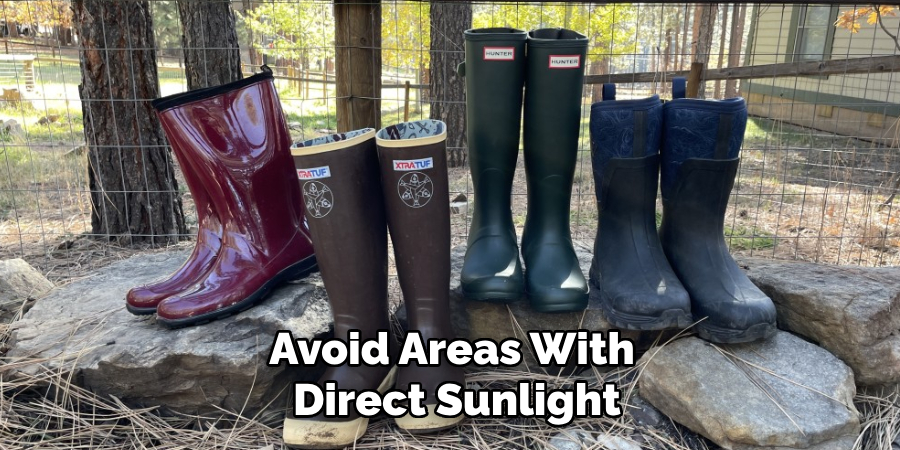
C. Protect from Harsh Elements
When wearing your Hunter boots outdoors frequently, protect them from harsh elements. Apply a UV protection product to shield them from sun damage, which can cause the rubber to dry out and crack over time. This added layer of protection helps preserve your boots’ integrity, ensuring they are ready for any adventure.
When to Consider Professional Repair or Replacement
A. Severe Damage
Professional intervention may be necessary if your Hunter boots have sustained severe damage, like deep cracks or tears in the rubber. These kinds of issues can significantly compromise the waterproofing of the boots, rendering them less effective in wet conditions.
Moreover, worn soles can severely affect the boot’s functionality and comfort. In such cases, taking them to a cobbler or shoe repair specialist for resoling is advisable, ensuring they retain their performance and durability over time.
B. Warranty Options
If your boots are relatively new and exhibit peeling or other issues, it is worth checking the warranty. Contact Hunter to explore the possibility of a replacement or professional repair. They might offer solutions under warranty, ensuring your boots are restored or replaced efficiently.
Frequently Asked Questions
1. What Should I Do if My Hunter Boots Continue to Peel After Following the Repair Steps?
If you’ve followed all the recommended repair and maintenance steps and your Hunter boots continue to peel, it might be time to reconsider professional repair options. Consulting a shoe repair specialist could provide a more thorough assessment and potential solutions. Additionally, check if your boots are still under warranty, as Hunter may offer a replacement or professional repair services.
2. Can I Use Regular Shoe Polish on My Hunter Boots to Maintain Their Shine?
Regular shoe polish on Hunter boots is not recommended, as it may not be suitable for the specific rubber material and could cause further damage. Instead, use products specifically designed for rubber conditioning or boot buffing compounds to maintain the shine and integrity of your boots without harming the material.
3. Are There Specific Cleaning Products I Should Avoid When Maintaining My Hunter Boots?
Yes, avoid using harsh chemicals or cleaning products like bleach or detergents with strong solvents, as these can degrade the rubber and cause further peeling or cracking. Stick to mild soap mixed with water to clean your boots, ensuring they are effectively cleaned without compromising the material’s quality.
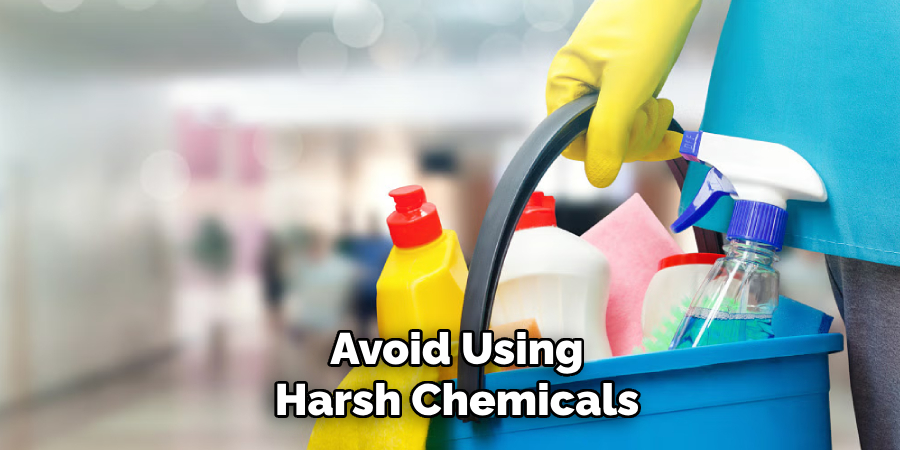
Conclusion
In summary, the process of how to fix peeling Hunter boots showcases a series of detailed steps designed to restore the integrity and aesthetics of your beloved footwear.
The repair involves initial cleaning to remove dirt and debris, optional sanding to smooth peeling edges, application of rubber adhesive for secure bonding, and ultimately conditioning the rubber to revive its durability and shine. Emphasizing the importance of maintenance, regular upkeep, and adequate storage is crucial in preventing future peeling, thus extending the lifespan of your boots.
Hunter boots represent an investment in quality, and with attentive care coupled with prompt repairs, you can ensure they endure over the years while retaining their iconic style and high functionality. This thoughtful approach to preservation ensures continued waterproof performance, supporting your every adventure.
